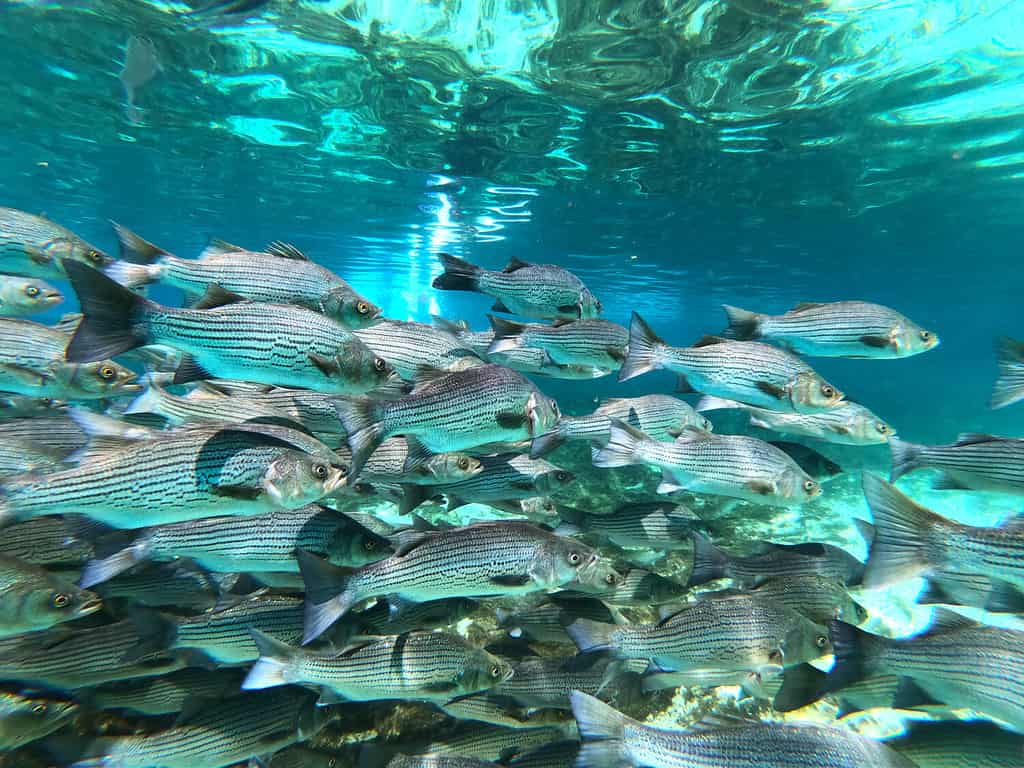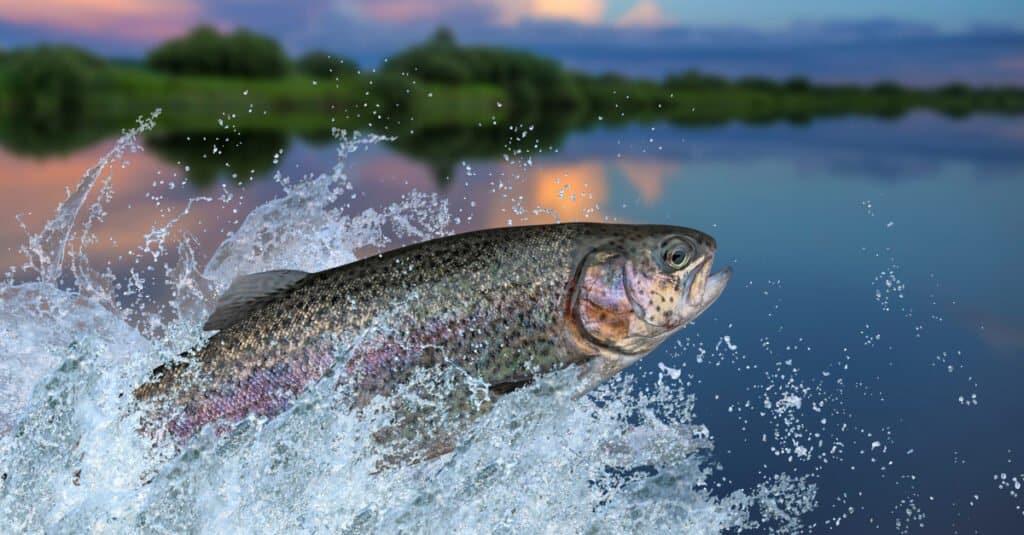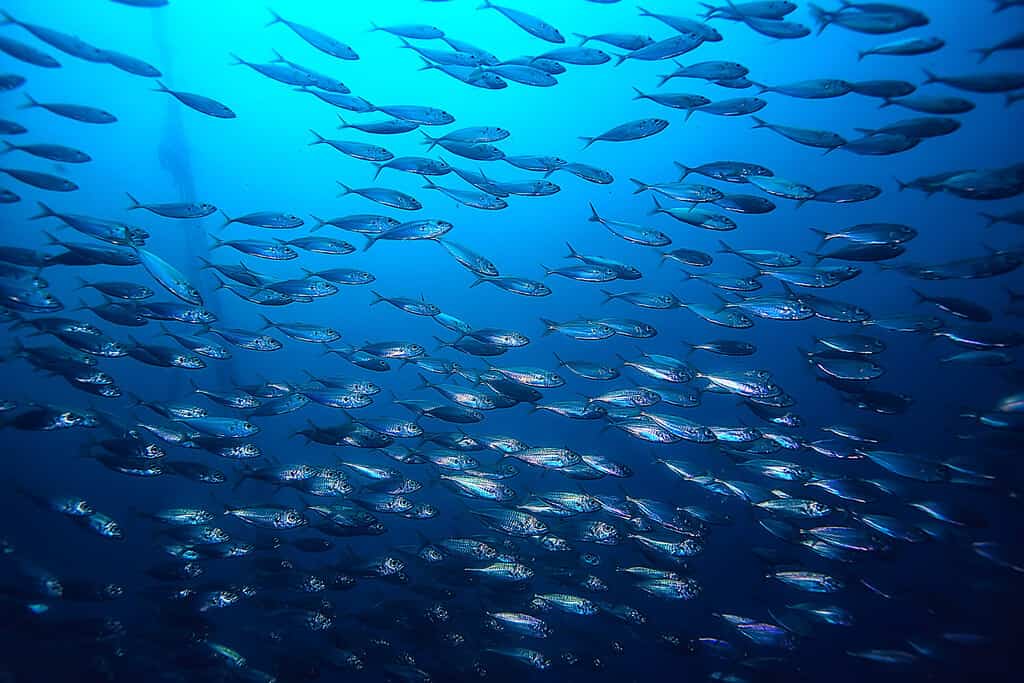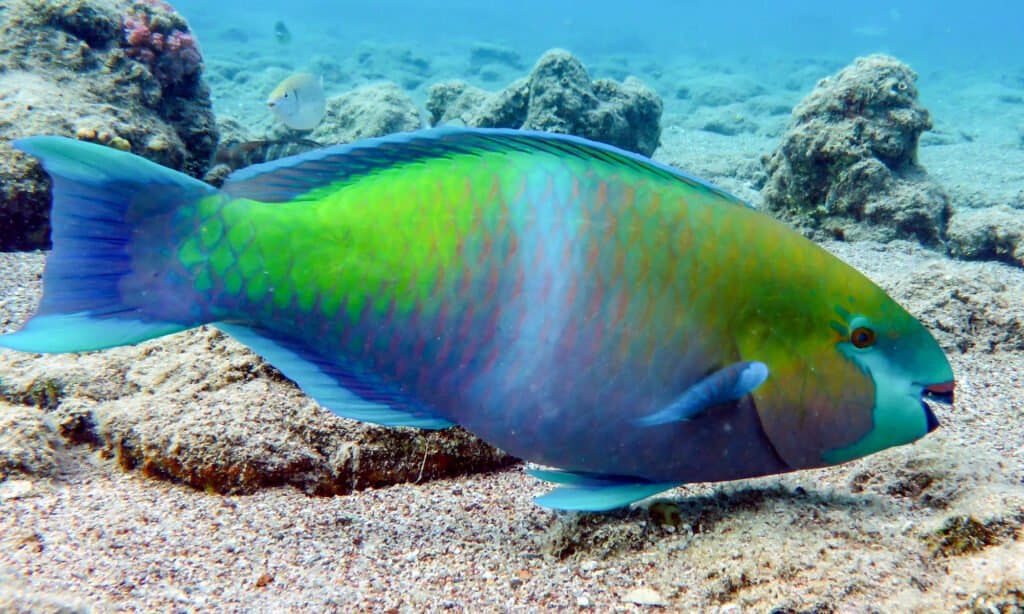A fish is an aquatic vertebrate animal that typically uses gills for respiration. Its skull can be either bony or cartilaginous. Its fins, limbs adapted especially for traversing an aquatic habitat, lack individual digits such as fingers or toes.
Summary
There are more than 34,000 species of fish. They make up an incredibly diverse group of animals and range in size from as little as 8 millimeters (various species of minnows) to more than 60 feet long (the whale shark). Their morphological diversity can mainly be attributed to the fact that the majority of the Earth’s surface is covered in water (around 70%).
Taxonomically, these aquatic animals are divided into three main superclasses: bony fishes, cartilaginous fishes, and jawless fishes. These superclasses can be further broken down into other taxonomically important classes and subclasses. For example, the bony fishes, Osteichthyes, mainly consists of the Actinopterygii and Sarcopterygii groups, the ray-finned and lobe-finned fishes, respectively. As their names imply, they primarily differ by the shape and structure of their fins.
The two main traits all species have in common are their aquatic habitats and the presence of a backbone. Another important trait they share is the presence of gills: thin, fleshy, heavily folded organs used for respiration. Fish breathe by using their gills to absorb oxygen from the water around them.
However, some unique species can also absorb oxygen through their skin or even respire with the use of lungs, such as the lungfish. Additionally, certain fish like the mudskipper are capable of storing water in pouch-like gill chambers to exit their aquatic habitats and “walk” on land for short periods of time.
The majority of fish species are ectotherms, or cold-blooded. However, some varieties like the opah, tuna, and even certain sharks can maintain a higher body temperature. Fish exist in nearly every type of body of water on Earth. Many species have adapted to withstand extreme temperatures and pressure such as in very cold or very deep waters.

The striped bass,
Morone saxatilis, is one example of more than 34,000 unique species of fish.
©Pelow Media/Shutterstock.com
Taxonomic Classification
Taxonomically, fish are divided into three main groups, or superclasses: bony, cartilaginous, and jawless.
- Agnatha: Jawless fishes. This small and basic yet evolutionarily crucial group consists of around 120 species. As their collective name suggests, these fish lack jaws. Examples of notable varieties include lampreys and hagfish.
- Chondrichthyes: Cartilaginous fishes. This group includes sharks, rays, sawfish, skates, and chimaeras. These animals have skeletons primarily composed of cartilage rather than bone. Additionally, they lack swim bladders and opercula, a set of bones present in the skulls of bony fishes. These fish are generally divided into two main subclasses: Elasmobranchii and Holocephali.
- Elasmobranchii: This group makes up the bulk of Chondrichthyes species. It includes sharks, rays, skates, and sawfish. Their main characteristics are their five to seven gill clefts, hard and upright dorsal fins, and skin covered in small placoid scales.
- Holocephali: The much smaller, more primitive subclass mainly consisting of one unique group, the chimaeras. It is also known as the ghost shark. Only around 50 living species belong to this group. Interestingly, they have no stomachs, large pectoral fins, and very long, thin tails.
- Osteichthyes, the bony fishes, can be further divided into two classes: ray-finned and lobe-finned fishes. Unlike the cartilaginous fishes, their skeletal structure is primarily made of bone.
- Actinopterygii: Ray-finned fishes. The name of this class is derived from ancient Greek: “actino-” meaning “having rays,” and “pterux,” meaning “wing” or “fin.” Their thin, lightweight fins are supported by long, bony rays. Around 50% of all known fish species are part of this group.
- Sarcopterygii: Lobe-finned fishes.These fish have larger, heavier fins that are supported by muscular buds, or lobes, rather than thin, bony rods. This small yet taxonomically and evolutionarily unique group consists of species like the coelacanth and lungfish.
Identifying Fish: Key Traits

Fish such as the rainbow
trout
have gills, fins, an aquatic habitat, and a backbone.
©FedBul/Shutterstock.com
Although fish are among the most morphologically diverse animals on the planet, they all still share four key traits. These include:
- Gills for respiration (though some species such as the lungfish can also use lungs for respiration)
- Fins for movement. These can vary significantly in shape, size, and even number.
- An aquatic habitat. This, as detailed below, can also vary, with most habitats either being saltwater, freshwater, or brackish in salinity.
- A vertebral column, better known as a backbone. Even the most primitive species like Agnathans, or the lamprey and hagfish, have backbones.
Notably, the acronym GFWB, or “gills, fins, water, backbone,” can be helpful as a mnemonic device to recall these key traits. Another trait often added to this list is the swim bladder, although swim bladders are only present in members of the Osteichthyes superclass. Finally, another lesser-known trait is the lateral line organ, or LLO, a system of sensory organs that these animals rely on to navigate as well as sense movement, vibrations, and even water pressure.
Fish Habitats

Nearly 60% of all fish species are saltwater-dwelling.
©Kichigin/Shutterstock.com
The habitats of fish are incredibly diverse and vary widely in salinity, temperature, pressure, turbidity, and much more. Because more than 70% of the Earth’s surface is water, they are among the most widespread animals on the planet. Their habitats can mainly be divided into two main types: saltwater and freshwater. However, we can also further break these down into smaller, more specific habitats below.
- Saltwater: The majority of species, or around 58%, are saltwater fishes. The main habitat for these fish is oceanic. The world’s four main oceans, the Atlantic, Pacific, Indian, and Arctic oceans comprise the bulk of known fish species.
- Freshwater: A lesser percentage of fish, or around 41%, exist in freshwater habitats. These include bodies of water like rivers, lakes, streams, ponds, and creeks.
- Brackish: This includes habitats like estuaries, where freshwater and saltwater habitats meet. These habitats are more salty than freshwater, yet not as much as saltwater oceanic habitats.
Fish Diets

The
parrotfish
is a rare example of a herbivorous fish. It uses its specialized jaws and teeth to mainly eat algae off of the coral reefs it inhabits.
©FromMyEyes/Shutterstock.com
Just like their morphology and habitat range, fish also have a wide variety of diets and dietary needs. They can be carnivorous, herbivorous, omnivorous, or even detritivorous. In general, the majority of fish species eat other, smaller fish and are either carnivores or omnivores. However, certain varieties like the parrotfish are entirely herbivorous and feed on algae and corals.
Fish Pronunciation
FISH




